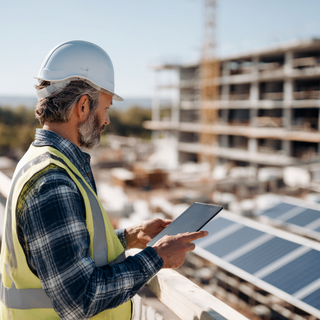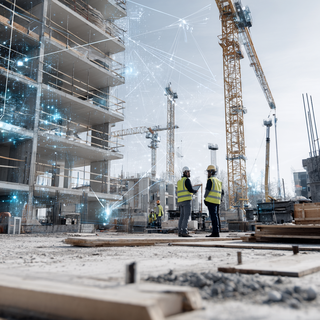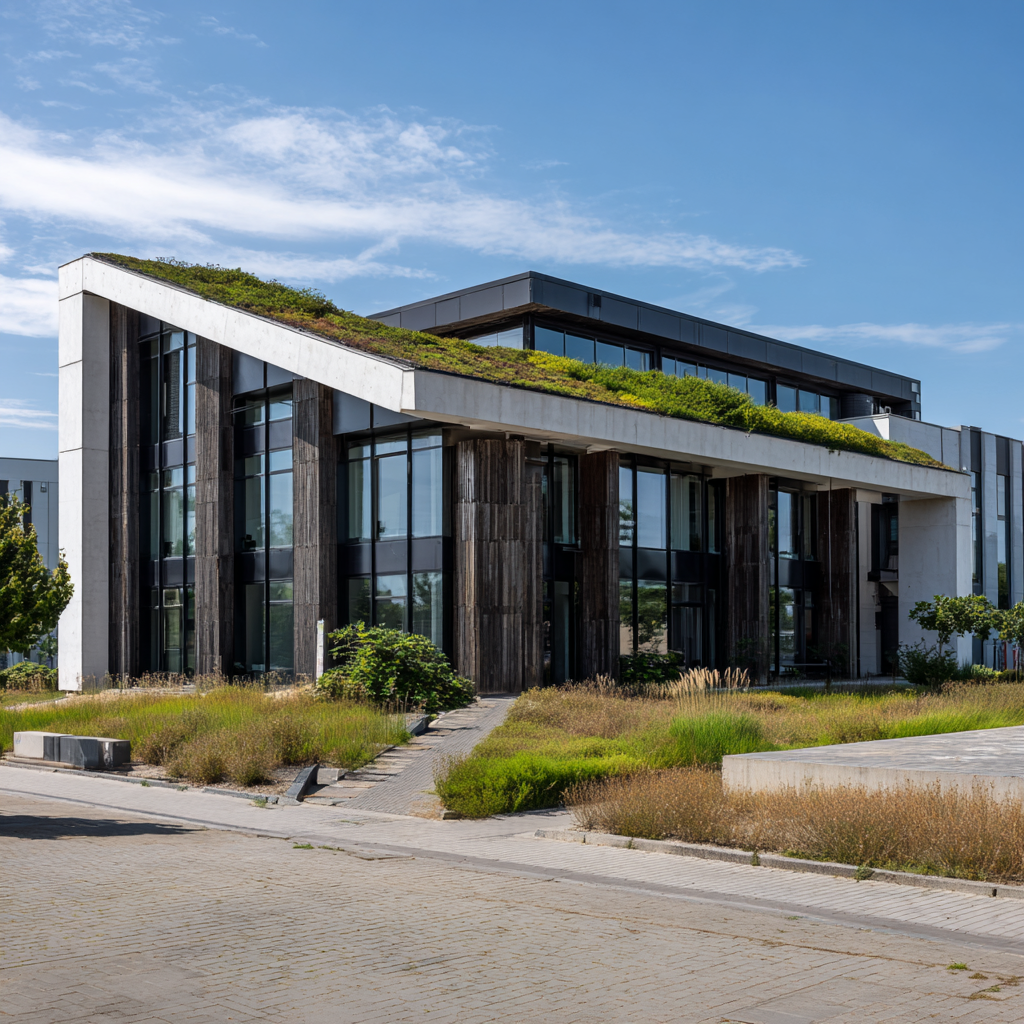Been hearing the buzz about “green skills”? It’s more than just a trend. It’s a seismic shift in the job market, and nowhere is that more obvious than in the world of construction and architecture. The global green building market is absolutely exploding, set to hit nearly $647 billion in 2025. This isn’t just about bolting on a few solar panels; it’s a complete reimagining of how we build—a move from gas-guzzling structures to high-performance, healthy environments. At FutureSkillGuides.com, I see this as the single biggest opportunity for anyone looking to build a career that doesn’t just pay the bills, but actively heals our planet. This guide is your blueprint to navigating this exciting landscape.
Why Green Building Is No Longer a “Nice-to-Have”
Let’s be blunt: traditional construction is a resource hog. It’s like driving a giant, inefficient SUV when the world needs a fleet of nimble EVs. Buildings and their supply chains gulp down over a third of global energy and are massive contributors to carbon emissions. The urgency of climate change and a growing demand for healthier places to live and work have dragged sustainable architecture from the fringe to the forefront.
The Environmental—and Economic—Mandate
Think of a green building as having a detailed nutritional label for its environmental impact. It’s meticulously designed to shrink its footprint across its entire life—from sourcing materials (its “birth”) to its operation and eventual deconstruction (“recycling”). This focus on energy efficiency, water conservation, and responsible materials isn’t just good karma; it’s fantastic for the bottom line, slashing operational costs and boosting property values.
This isn’t just wishful thinking. The proof is in the paperwork. The U.S. Green Building Council saw a staggering 51% jump in new LEED project registrations in 2023. That’s not a trend; it’s a tidal wave of demand for people who know how to build this way.
The Bedrock Principles of Green Building
To find your place in this world, you first need to understand its language. These are the core tenets that everything else is built upon:
- Energy Efficiency: This is about being smart, not just strong. It means designing buildings that work *with* nature—using passive solar design to capture winter sun, natural ventilation to reduce cooling loads, and installing hyper-efficient HVAC and lighting systems.
- Water Conservation: Treating water like the precious resource it is. This involves everything from low-flow fixtures and rainwater harvesting to designing landscapes that don’t need constant irrigation.
- Sustainable Materials: Choosing materials is like casting for a play—every choice matters. We’re talking recycled steel, sustainably harvested timber, and wild innovations like low-carbon concrete. The goal is low “embodied energy”—the hidden energy cost of producing and shipping materials.
- Indoor Environmental Quality (IEQ): This one’s personal. It’s about creating spaces that help people thrive, with clean air, abundant natural light, and comfortable acoustics. It’s the difference between a building that drains your energy and one that recharges you.
- Smarter Site Selection: It starts before the first shovel hits the ground. It means choosing locations that minimize ecological damage, protect habitats, and plug into public transport.
- Waste Reduction & Circularity: The old model was “build and bulldoze.” The new model is circular. Thinking about how a building can be deconstructed and its materials reused from day one. It’s a radical, necessary shift.
Key Career Paths: Where Do You Fit In?
The beauty of the green building sector is its diversity. It’s not just for architects. It’s a whole ecosystem of roles. Here are some of the heavy hitters:
1. Sustainable Architect / Environmental Architect
These are the visionaries, embedding sustainability into a building’s DNA from the first sketch. They are masters of blending form, function, and environmental performance. An environmental architect’s salary reflects this specialized skill, averaging around $102,998, a significant “sustainability premium” over traditional roles. (Hutter Architects).
- What they do: Design eco-centric structures, run energy models to predict performance, and champion sustainable materials. They are the keepers of the green vision.
- Essential skills: Design chops, deep knowledge of building physics, fluency in energy modeling software (like EnergyPlus), and an encyclopedic understanding of certifications like LEED or BREEAM.
2. Green Construction Manager / Sustainable Construction Supervisor
If architects are the visionaries, these are the commanders on the ground. They turn the green blueprint into a physical reality, ensuring that sustainable practices aren’t just talked about but are actually *implemented* on-site. This is a tough, critical job, with average salaries around $95,168 according to ZipRecruiter.

A green construction manager ensuring sustainable practices are implemented on-site.
- What they do: Juggle budgets, manage sustainable material orders, implement complex waste-reduction plans, and keep the project compliant with all environmental regs.
- Essential skills: Iron-clad project management, expertise in green construction methods (like Passive House standards), and the leadership to keep a diverse team focused on the sustainability goals.
3. Sustainability Consultant / Green Building Consultant
Think of these pros as personal trainers for a building’s health. They are brought in as expert guides to help a project team navigate the complexities of sustainability, from achieving a specific LEED certification to auditing a building’s energy performance. It’s a role that requires deep expertise and exceptional communication skills.
- What they do: Conduct sustainability audits, map out green strategies, and steer projects through the often-bewildering certification process (e.g., LEED, WELL).
- Essential skills: An almost-obsessive knowledge of green rating systems, sharp analytical abilities, and a talent for making the technical understandable to non-experts.
4. Energy Engineer / Building Performance Specialist
These are the performance gurus, hyper-focused on one thing: a building’s energy diet. They design ultra-efficient systems and integrate renewables like solar or geothermal. It’s a highly technical field with salaries for top-tier renewable energy engineers pushing past $150,000. (Build-News).
- What they do: Conduct energy audits, design hyper-efficient HVAC and lighting systems, and model building performance to squeeze out every possible watt of savings.
- Essential skills: A strong foundation in thermodynamics and electrical systems, mastery of simulation software, and deep knowledge of renewable tech.
5. Landscape Architect (Sustainable Focus)
Their canvas is the space *around* the building. Sustainable landscape architects do so much more than make things look pretty. They design ecosystems—green roofs that insulate, rain gardens that manage stormwater, and public spaces that connect people with nature.
- What they do: Analyze a site’s ecology, design green infrastructure, manage stormwater naturally, and select native plants that thrive without excessive intervention.
- Essential skills: A blend of design artistry and ecological science, hydrology, and a deep understanding of sustainable urbanism.
The Essential Green Toolkit: Beyond the Degree
Success in this field is a cocktail of hard tech skills, crucial soft skills, and a genuine passion for the mission.
Technical Skills
- Green Building Certifications: You need to be fluent in the major rating systems: LEED, BREEAM, WELL, and Passive House. Knowing *of* them isn’t enough; you need to know how they work in practice.
- Energy Modeling & Simulation: Proficiency in tools like IES VE, EnergyPlus, and the sustainable design features within Revit is non-negotiable for many roles. But here’s a crucial counterpoint: these tools are only as good as the data you feed them. A model can’t replace a fundamental understanding of building science.
- Building Information Modeling (BIM): BIM is the digital twin of a construction project. It’s the central nervous system for integrated design, allowing teams to spot clashes and analyze the carbon footprint of materials *before* they’re ordered.
- Sustainable Materials Knowledge: This goes beyond a simple list. It’s understanding the full lifecycle—the “embodied carbon”—of everything from insulation to steel.
Soft Skills
- Problem-Solving: I once worked on a project where our specified reclaimed wood was suddenly unavailable. The ability to pivot, find a new sustainable option that met the budget, and get client buy-in—that’s the real-world skill that matters.
- Collaboration and Communication: Initially, you might think technical prowess is everything. But I’ve come to believe the real differentiator is communication. Can you explain the long-term value of a pricier, more efficient HVAC system to a skeptical CFO? That’s the million-dollar skill.
- Adaptability and Lifelong Learning: The tech and materials in this space are evolving at lightning speed. You have to be hungry to learn. What was best practice two years ago might be obsolete today.
Technology Isn’t Just Helping—It’s Revolutionizing the Field
Thinking about it more… it’s funny how we often fixate on the most futuristic tech. And don’t get me wrong, AI and digital twins are game-changers. But we can’t forget that sometimes the most powerful “tech” is a simple, elegant design choice, like orienting a building to maximize daylight. Technology should be our co-pilot, not the sole navigator.

Digital platforms and smart building tech are becoming the standard toolkit for sustainable construction.
- Building Information Modeling (BIM): BIM has moved from a “nice-to-have” to the absolute core of green design. It allows for a holistic view, simulating everything from energy use to the carbon footprint of materials in real-time.
- Smart Building Tech & IoT: We’re creating buildings with nervous systems. Sensors and AI now manage lighting, HVAC, and energy use based on real-time occupancy and weather data, constantly optimizing for efficiency.
- Modular Construction & 3D Printing: Building in a factory and assembling on-site slashes waste and construction time. It’s a paradigm shift in efficiency.
- Digital Twin Technology: A living virtual replica of a building allows for constant monitoring and predictive maintenance. It’s like having a permanent check-up for the building’s performance throughout its entire life.
Myth-Busting: “Isn’t Green Building Just More Expensive?”
Let’s tackle the elephant in the room. The most common pushback is cost. And it’s true, some green features can have a higher upfront investment. But framing it as “more expensive” is a myth because it ignores the total cost of ownership.
A high-performance building envelope and an efficient HVAC system might cost more initially, but they can slash energy bills by 30-50% or more for decades. It’s the classic short-term vs. long-term thinking. A truly skilled green professional knows how to demonstrate this lifecycle ROI, turning the conversation from cost to investment.
Actionable Steps to Launch Your Green Building Career
Ready to jump in? Here’s a no-fluff plan to get started.
1. Education and Specialization
- Formal Education: If you’re starting out, look for degrees in architecture, engineering, or construction management that have a dedicated sustainability track.
- Upskill with Courses: Already in the field? Bolster your resume with specialized training. A fantastic place to begin is by understanding the bigger picture with guides like our own on Sustainable Project Management.
2. Get the Right Certifications
In this industry, certifications are your credibility badge. They prove you have a standardized, vetted level of expertise.
- LEED Green Associate: This is the essential first step. It shows you speak the language.
- LEED AP (Accredited Professional): The next level up, with specializations in different project types. This is a major differentiator.
- WELL AP: If your passion is the intersection of buildings and human health, this is for you.
- Passive House Certification: For those who want to specialize in creating ultra-low energy, airtight buildings.
3. Develop and Showcase Your Skills
- Master the Software: Get hands-on with BIM and energy modeling tools. Even free or trial versions can help you build foundational skills.
- Build a Portfolio: This is key. Showcase any project—even academic ones—where you applied sustainable principles. Here’s a unique recommendation: conduct a mini-sustainability audit of your own home. Document your findings on energy use, water, waste, and potential improvements. It’s a fantastic, practical way to demonstrate your thinking.
4. Network and Get Experience
- Join Professional Organizations: Get active in your local chapter of the USGBC or the AIA Committee on the Environment (COTE). The connections you make there are invaluable.
- Seek Out Experience: Don’t be afraid to start small. Internships, volunteer work with organizations like Habitat for Humanity on a green project, or even just informational interviews can open doors.
Future Outlook: What’s Next on the Horizon?
The momentum is only building. The market is projected to soar past $933 billion by 2029, according to The Business Research Company. This isn’t a bubble; it’s the new baseline.

The future is net-zero, biophilic, and deeply integrated with smart technology.
- Net-Zero Everything: The goalpost is shifting from “more efficient” to “net-zero carbon”—addressing not just operational energy but also the embodied carbon in all the materials.
- Biophilic Design: More than just adding a few potted plants. This is a deep integration of nature—natural light, air, patterns, and materials—into building design to improve our well-being.
- Climate Resilience: Buildings will be designed not just to be green, but to be tough—able to withstand the extreme weather events that are becoming all too common.
- Deep Circularity: The industry will fully embrace designing for disassembly. Imagine buildings as material banks for future projects.
- AI-Driven Optimization: Artificial intelligence will become indispensable for optimizing every facet of a building’s lifecycle. Our guide on AI productivity tools explores how this tech is already changing workflows.
Author’s Final Thought
After more than a decade in this field, what strikes me most isn’t the technology or the certifications—as important as they are. It’s the people. The passion and ingenuity I see every day from architects, engineers, builders, and tradespeople who are committed to doing things differently give me immense hope. A career in this space is demanding. You’ll be challenged constantly by budgets, by convention, by physics itself. But it is, without a doubt, one of the most rewarding paths you can choose. You’re not just constructing buildings; you’re building a better, more sustainable future. One blueprint at a time.
Frequently Asked Questions
What is the average salary for a sustainable architect?
As of mid-2025, the average annual salary for an environmental architect in the U.S. hovers around $102,998, with a typical range between $91,370 and $115,278. This often represents a significant ‘sustainability premium’ over traditional architectural roles, with top experts earning well over $138,000.
What are the most in-demand skills in green construction?
Top skills include deep knowledge of green building certifications (especially LEED), energy modeling, waste management protocols, sustainable material sourcing, and renewable energy integration. Critically, strong collaboration skills and proficiency in BIM (Building Information Modeling) are essential to success.
How is AI impacting sustainable architecture and construction?
AI is a massive accelerator. It’s used for generative design to explore thousands of sustainable options, for real-time performance analysis of energy and carbon, and for optimizing building operations via smart systems. For more on this, our guide on AI productivity tools offers a broader look.
What certifications are valuable for a career in green building?
The most respected certifications are LEED Green Associate and the more advanced LEED AP. Others that carry significant weight are the WELL AP (focusing on health), Certified Energy Manager (CEM), and credentials for Passive House design.
Can I transition into green building from a traditional construction background?
Absolutely. Your existing skills are a fantastic foundation. The most common path is to add specialized knowledge through certifications (like LEED Green Associate), take courses on green building principles, and actively seek roles on projects with sustainability goals. Our guide on understanding green skills is the perfect place to start that journey.
What is “embodied carbon” in green building?
Embodied carbon is the “hidden” carbon footprint of a material. It includes all the greenhouse gas emissions from extracting, manufacturing, transporting, and installing it. A key goal in advanced green building is to slash embodied carbon by choosing smarter, locally-sourced, and recycled materials.
How do green buildings contribute to occupant health?
They contribute immensely by focusing on Indoor Environmental Quality (IEQ). This means using non-toxic, low-VOC (volatile organic compound) materials, providing superior ventilation and filtered air, maximizing daylight, and improving acoustics. The result is a healthier, more productive, and more comfortable indoor environment.
What is the role of smart grids in sustainable construction?
Smart grids allow buildings to have a two-way conversation with the electrical grid. A green building can intelligently reduce its energy consumption during peak demand hours and can even sell its own solar-generated energy back to the utility. This integration makes the building an active, helpful participant in a more resilient and renewable energy system.






Leave a Reply